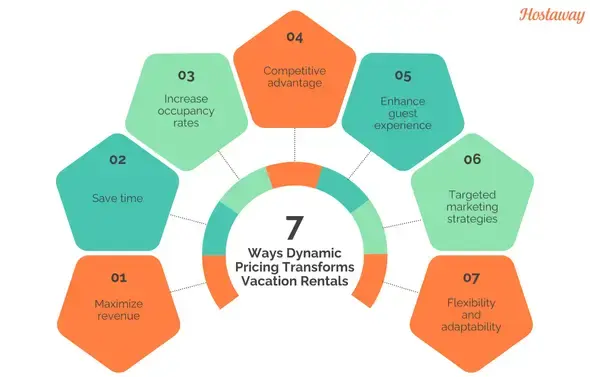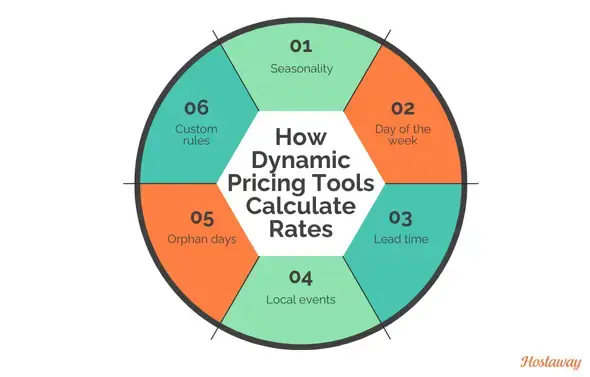Dynamic Pricing for Vacation Rentals: Everything You Need to Know
%20(1).webp?u=https%3A%2F%2Fimages.ctfassets.net%2Fpqmtoyw9z10u%2F6wtjKoKKtSGagPD6DWrW7Z%2Fbce190ed584a50a807e2f6aff5eec1b8%2FDynamic_Pricing_for_Vacation_Rentals__2___1_.webp&a=w%3D960%26h%3D549%26fm%3Dwebp%26q%3D75&cd=2024-12-16T04%3A41%3A46.141Z)
Key Takeaways
Dynamic pricing automatically adjusts short-term rental rates in real time based on demand, seasonality and market trends to maximize both revenue and occupancy.
It saves time, enhances competitiveness and ensures fair, transparent pricing that improves guest trust and satisfaction.
Key pricing factors include seasonality, day of the week, lead time, local events and orphan days — all optimized by smart algorithms.
AI-powered tools like Hostaway Dynamic Pricing analyze billions of data points daily to deliver optimal rates and customizable pricing strategies.
Embracing AI-driven dynamic pricing helps property managers boost profits, streamline operations and stay competitive in a rapidly evolving vacation rental market.
Dynamic pricing for short-term rentals is all about striking the perfect balance — charging rates that aren’t too high to drive guests away or too low to leave money on the table, but just right.
Of course, finding this “Goldilocks zone” is easier said than done. Unlike Goldilocks, who only had to consider the temperature of her porridge, short-term rental managers face a far more complex challenge.
Fluctuating demand, seasonal trends, nearby happenings and market competition all play a role in getting the price just right. That’s where dynamic pricing technology takes the spotlight, simplifying this intricate balancing act with smart, data-driven precision, powered by extensive market data.
Let’s break down how it works and why it’s the ultimate tool for optimizing your vacation rental business.

What is Dynamic Pricing?
You might already be familiar with dynamic pricing under a different name — surge pricing. If you've taken an Uber or Lyft during busy times you've probably noticed how the fare can jump. That's dynamic pricing at work.
Dynamic pricing is the practice of automatically adjusting prices in real-time based on market demand, competitor pricing and other factors.
For vacation rentals, this means adjusting your nightly rates based on seasonality, local events, booking trends and even weather conditions.
Just like Uber ensures they give riders the best price, dynamic pricing helps you fill your vacation rental and increase revenue.
How Dynamic Pricing Can Transform Your Vacation Rental Business

1. Maximize revenue
By adjusting your prices in response to demand, you can ensure that you are charging the optimal rate for your property at any given time.
During high-demand periods, such as holidays or local events, you can increase your rates to maximize revenue.
Conversely, during off-peak times, like the low season, lowering your prices can attract more bookings, ensuring that your property remains occupied and improving both your revenue and occupancy rate.
Example: A beachside vacation rental could increase its rates during the summer months when demand is high and offer discounts during the winter to attract guests who might not otherwise consider staying.
2. Save time
You could do it all manually. Monitoring your competitors' price points, analyzing your own historical data for seasonal fluctuations, staying on top of market trends — it's possible.
But why would you spend all that time excruciatingly analyzing the data when a dynamic pricing algorithm can do it for you?
3. Increase occupancy rates
Dynamic pricing helps you maintain a higher occupancy rate throughout the year. By offering competitive rates during low-demand periods, you can attract budget-conscious travelers who might not have considered your property at higher prices.
Example: A mountain cabin could lower its rates during the off-season to attract guests looking for a quiet retreat, thus maintaining steady bookings year-round.
4. Competitive advantage
Staying competitive in the vacation rental market means keeping your prices in line with what similar properties are charging.
Dynamic pricing tools allow you to monitor your competitors' rates and adjust your own accordingly, ensuring that you are neither overpriced nor underpriced.
Example: If a major event is happening in your area and competitors are raising their rates, dynamic pricing tools can automatically adjust your prices to remain competitive.
5. Enhance guest experience
Transparent and fair pricing can lead to better guest satisfaction. Guests appreciate knowing that they are getting a good deal, which can lead to positive reviews and repeat bookings.
Example: Clearly communicating that your prices are dynamic and based on demand can build trust with potential guests, as they understand that they are getting a fair price based on the current market.
6. Targeted marketing strategies
Dynamic pricing can be used in conjunction with campaigns to boost visibility and attract more bookings. For instance, special promotions or discounts can be strategically timed to fill gaps in the booking calendar.
Example: Launching a “Last-Minute Deal” campaign for unbooked dates in the near future can entice spontaneous travelers and increase occupancy.
7. Flexibility and adaptability
The ability to quickly adjust prices in response to market changes makes your business more agile and adaptable. This flexibility can be crucial in responding to unexpected events, such as sudden changes in travel restrictions or economic conditions.
Example: In case of a sudden travel ban, a property owner can quickly lower prices to attract local travelers looking for a staycation, maintaining occupancy despite travel restrictions.
Benefit | What It Means | Example in Action |
Maximize revenue | Adjusts rates up during peak demand and down in slower seasons to keep earnings steady. | A beach rental raises rates in summer and discounts in winter to fill nights. |
Save time | Automates competitor monitoring and data analysis, reducing manual effort. | Algorithms instantly adjust rates instead of hosts recalculating daily. |
Increase occupancy | Keeps bookings flowing year-round by offering competitive prices in low-demand periods. | A mountain cabin drops rates in off-season to attract budget travelers. |
Competitive advantage | Tracks competitor prices and adjusts automatically to stay aligned. | Rates rise when other local rentals increase pricing for an event. |
Enhance guest experience | Creates transparency and fair pricing, which builds trust. | Guests see clear demand-driven pricing and leave positive reviews. |
Targeted marketing | Aligns discounts/promotions with booking gaps to boost visibility. | A “Last-Minute Deal” fills unbooked midweek dates. |
Flexibility & adaptability | Responds quickly to unexpected changes in demand or restrictions. | During travel bans, a host lowers rates to attract local staycationers. |
How to Use Dynamic Pricing for Your Vacation Rental
.webp?u=https%3A%2F%2Fimages.ctfassets.net%2Fpqmtoyw9z10u%2F7GbDbVwfxfJEvu2BIHevwE%2Fc95bfd361b1406e2f07aa36af2ffc3f4%2FHow_to_Use_Dynamic_Pricing_for_Your_Vacation_Rental__1_.webp&a=w%3D590%26h%3D337%26fm%3Dwebp%26q%3D75&cd=2024-12-16T04%3A35%3A50.129Z)
Implementing dynamic pricing effectively involves several key steps and considerations:
1. Choose the right tool
There are plenty of tools out there to help with dynamic pricing.
You can use analytics tools and manually decide and update prices regularly. There are also point solutions like Wheelhouse and Pricelabs that use sophisticated algorithms and adjust rates based on real-time data and market trends.
But with an all-in-one vacation rental software like Hostaway, you get seamless, intelligent pricing adjustments and valuable market insights — all in one easy-to-use platform. Plus, you can set prices for properties worldwide with just one click, making it easy for anyone, anywhere, to get started.
2. Set a base price
Your base price should cover your costs and desired profit margin during low-demand periods. This price will be the foundation upon which dynamic adjustments are made.
Determine your base price by calculating your fixed costs, variable costs and desired profit margin. If your costs are $70 per night and you want a $30 profit, set your base price at $100 per night.
3. Define pricing rules
Establish rules for adjusting your prices based on factors such as seasonality, local events, booking window and local competitor rates.
For example, set rules to increase prices by 20% during major holidays and by 10% during local festivals. Similarly, set discounts for bookings made more than six months in advance.
4. Monitor and adjust
Regularly review the performance of your listing's pricing strategy and make necessary adjustments based on booking patterns and market trends.
Use analytics to track which periods have lower occupancy and adjust your rules to offer discounts during those times, ensuring your property remains competitive.
Dynamic Pricing vs. Revenue Management: What’s the Difference?
Dynamic pricing is a component of revenue management, but they’re not interchangeable.
.webp?u=https%3A%2F%2Fimages.ctfassets.net%2Fpqmtoyw9z10u%2F2OtTRRxc4RpFu22SirgYEL%2F8f97eea8ef9a7ac673daa97dbc53192a%2FDynamic_Pricing_vs._Revenue_Management__1_.webp&a=w%3D590%26h%3D377%26fm%3Dwebp%26q%3D75&cd=2024-12-16T04%3A37%3A20.974Z)
While both rely on data and technology, revenue management takes a more holistic approach to maximizing profitability.
How Dynamic Pricing Tools Calculate Rates
Dynamic pricing tools rely on advanced algorithms to analyze multiple factors and determine the best rates for your property. Let’s break down these key factors:

1. Seasonality
Vacation rental demand often follows predictable patterns based on the time of year. For instance, beach properties are popular in summer, while mountain cabins peak in winter.
Dynamic pricing tools use historical trends to anticipate these fluctuations and adjust your rates accordingly, ensuring you’re maximizing profits during high seasons and staying competitive during quieter periods.
2. Day of the week
Weekends are generally more popular for travelers than weekdays, leading to higher demand and higher rates.
A dynamic pricing tool accounts for these patterns and automatically adjusts your rates to capitalize on peak days, while offering competitive pricing on slower days to attract more bookings.
3. Lead time
Lead time refers to how far in advance a booking is made. Demand driven pricing tools offer flexibility by adjusting rates based on booking windows.
They might apply discounts for last-minute bookings to fill vacant dates or reward early planners with lower rates to secure reservations well in advance.
4. Local events
Major events like music festivals, conferences or sports games can significantly increase demand for accommodations in your area.
Dynamic pricing tools monitor event schedules and competitor occupancy trends to raise your rates when demand spikes, ensuring you’re not leaving money on the table.
5. “Orphan days”
Orphan days are those awkward gaps between longer reservations — typically one or two nights that are harder to fill.
To make these dates more appealing, smart pricing tools automatically lower rates, encouraging guests to book these short stays and helping you maintain consistent occupancy.
6. Custom rules
While smart pricing algorithms are powerful, you remain in control. Most dynamic pricing tools allow you to set custom pricing parameters, such as minimum and maximum prices, ensuring your property aligns with your overall strategy.
For example, you can protect your margins by establishing a base rate or cap rates during certain periods to stay competitive.
Dynamic Pricing Strategies for Vacation Rentals
Knowing how dynamic pricing works is one thing — but using it strategically is what really moves the needle. The right approach depends on your property type, market and booking patterns, but here are a few tried-and-tested strategies that help hosts and property managers make the most of dynamic pricing.
1. Seasonal strategy
Start by identifying your high and low seasons. Increase your base rates during peak demand periods, such as summer holidays or ski season and lower them during quieter months to keep bookings steady. This approach ensures consistent occupancy and helps you capture maximum revenue throughout the year.
2. Event-based adjustments
Keep an eye on local events, festivals and conferences that can boost demand. A well-timed rate increase of even 10–20% during these periods can significantly improve your margins — without deterring travelers who expect higher prices during peak times.
3. Length-of-stay incentives
Encourage longer bookings by offering discounts for week-long or month-long stays. This reduces turnover costs and fills your calendar more efficiently. Some dynamic pricing tools can automatically apply these discounts when guests search for extended stays.
4. Last-minute discounts
Empty nights are missed revenue. Offering small, time-sensitive discounts (like 10% off for bookings made within three days of check-in) can help fill last-minute gaps, especially during slower periods.
5. Minimum stay adjustments
Adjust your minimum stay requirements dynamically. During high season, a three-night minimum might make sense, but lowering it to one or two nights in the off-season can attract more bookings and fill short calendar gaps.
6. Competitive benchmarking
Regularly compare your property’s rates against similar listings in your area. Dynamic pricing tools do this automatically — ensuring you’re never priced too high or too low relative to the market.
7. Guest segment targeting
Use insights from your booking data to tailor rates to different guest types. For example, offer midweek discounts to attract remote workers or weekend packages for couples. Aligning pricing with guest behavior helps drive bookings that fit your ideal occupancy mix.
Boost Your Profits with AI-Driven Dynamic Pricing in Short-Term Rentals
.webp?u=https%3A%2F%2Fimages.ctfassets.net%2Fpqmtoyw9z10u%2F353H53U1klPAzYb1OctCeO%2Fb47464030d748aa307908ed5b92b366d%2FUnlock_the_Full_Potential_of_Your_Vacation_Rental_Business_with_Hostaway_Dynamic_Pricing__1_.webp&a=w%3D590%26h%3D337%26fm%3Dwebp%26q%3D75&cd=2024-12-16T04%3A40%3A58.592Z)
According to the 2024 Hostaway AI in the Short-Term Rental Industry report, AI is revolutionizing the short-term rental market, especially in pricing. Over 40% of professionals use AI to set dynamic and optimized prices, making it the top AI/ML application in this industry.
Among large-portfolio property managers and vacation rental owners, 46% have seen improved profits thanks to AI tools such as dynamic pricing while 63.8% believe AI will give them a competitive advantage in their market.
Clearly, AI-driven dynamic pricing is transforming how short-term rentals operate, leading to better profitability and competitiveness.
By utilizing advanced tools and AI-powered technologies, you can make informed decisions, forecast market trends and customize pricing strategies to match demand fluctuations. Adopting dynamic pricing software will help your vacation rental business flourish and stay ahead in a competitive industry.
Hostaway Dynamic Pricing
Hostaway Dynamic Pricing analyzes billions of rental data points in real-time to provide optimal nightly rates for your listings.
With rates automatically adjusted daily, based on demand, time-to-booking and upcoming occupancy and revenue, this tool ensures your property is always competitively priced.
The tool features one-click activation and offers flexible risk profiles, allowing you to customize your pricing strategy. You can manually set prices by date or date range, define minimum prices and minimum stays and more.
Book a demo to find out how Hostaway's vacation rental pricing tool can help your vacation rental business flourish and stay ahead in a competitive industry.
FAQs
1. What is dynamic pricing?
Dynamic pricing, also known as demand pricing or time-based pricing, is a strategy where the price of a product or service is adjusted in real-time based on various factors such as market demand, competitor pricing, seasonality, local events, booking trends and weather conditions.
2. How can dynamic pricing increase my revenue?
By adjusting your prices in response to demand, dynamic pricing ensures you charge the optimal rate at any given time.
3. How do I set a base price for dynamic pricing?
Set your base price by calculating your fixed costs, variable costs and desired profit margin. For example, if your costs are $70 per night and you want a $30 profit, set your base price at $100 per night.
4. What factors should I consider when defining pricing rules?
Consider factors such as seasonality, local events, lead time and competitor rates. For example, increase prices by 20% during major holidays and by 10% during local festivals.
Offer discounts for bookings made more than six months in advance to encourage early reservations.
Ready to find out how Hostaway can transform your business?
